Samsung Galaxy S III Review - AT&T and T-Mobile USA Variants
by Brian Klug on June 20, 2012 12:01 AM ESTWe’ve already seen dual core Krait (MSM8960) performance before and talked about it in the HTC One X (AT&T) review. For the most part, what we see with the USA SGS3 variants is largely the same as what we saw in MSM8960 (or MSM8260A, the same part with different baseband).
If you’re looking for a comparison to the International SGS3 with Exynos 4412, my unit hasn’t quite arrived yet. Anand and I plan to take a comprehensive look at the SoC performance landscape (Tegra 3 / MSM8960 / Exynos 4412) in another review after we’ve had time with the international SGS3. I have benchmark numbers from our SGS3 international preview at the launch event, but those were from pre-final software.
Where the SGS3 differentiates itself from what’s becoming a slew of USA-bound devices with MSM8960 is available RAM. In this case, all of the USA SGS3s include 2 GB of LPDDR2 RAM, of which 1.62 GB is available to user applications. My own suspicions for why this is the case is that Samsung wanted to make sure they had at least 1 GB available for user space applications. Clearly there is 380 MB absorbed for both preallocated GPU memory, and possibly DRM / baseband, and after that subtraction the only way to get dual channel (2x32b) LPDDR2 is to make the jump to two 1 GB LPDDR2 devices.
That’s my own speculation, but either way with the SGS3 you get ample RAM for applications. The positive thing is that even if you launch a ton of applications, it’s unlikely they’ll get tombstoned. I fired up my regular set of daily driver applications (twitter, baconreader, chrome, messaging, speedtest, radarscope, and a few others) and managed to use up nearly 1 GB.
JavaScript Performance
Although smartphones are clearly headed for a life beyond as a communications tool, web browsing, or phone duties, we are still lacking the tools to measure performance in areas other than a component of web page performance. Measuring JavaScript performance is one component of the entire web page rendering process but it’s the most mature in terms of something we can benchmark.
Sunspider 0.9.1 is quite possibly the most well known of these JavaScript tests, and a regular staple of our testing suite:
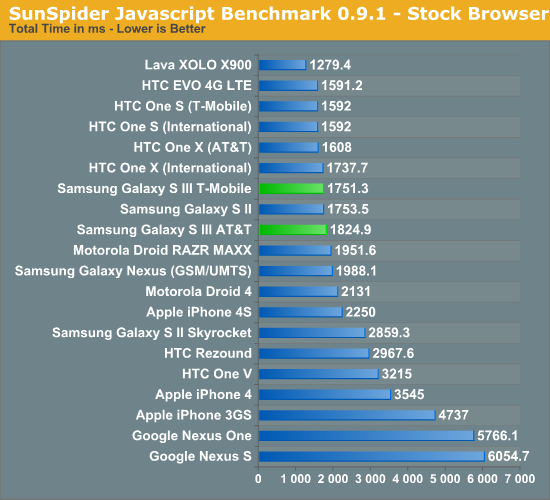
Like the other 1.5 GHz MSM8960 devices, the SGS3 does pretty well, but still is around 150ms slower. I ran this test multiple times but consistently got results in the 1750s or low 1800s for the SGS3s.
Browsermark is the next JavaScript test in our suite, and here it does very favorably against the rest of the competition.
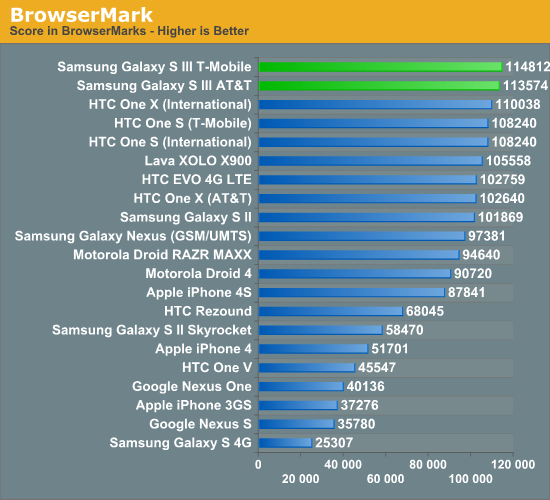
It’s interesting to see the SGS3 not do stellar in Sunspider, but excellent in Browsermark. Note that in our preview piece, I did see the International SGS3 post a score of 161k here.
Next up is Vellamo, which is a Qualcomm benchmark developed originally for OEMs to use and optimize their browser performance, and later released for general use. It’s a regular member of our test suite and includes both JavaScript tests and scrolling tests that stress the display composition and hardware acceleration in the browser.
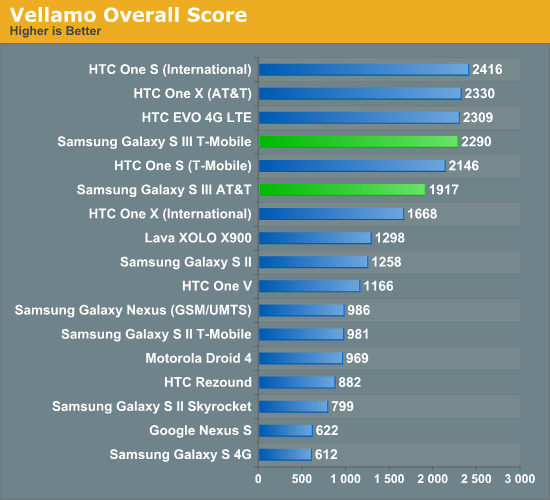
I saw an interesting deviation here between the AT&T and T-Mobile version, for reasons I cannot explain despite multiple reboots and making sure everything was closed. Either way, the devices both have stock browsers that feel like butter, absolutely smooth when translating or zooming around.
Low Level FP Performance
Linpack isn’t a great indication of overall smartphone performance, but it is a good test of the floating point capabilities of the CPUs in these SoCs. ARM has steadily been improving FP performance for the past few generations but we’re going to see a big jump to Krait/A15. As most client smartphone workloads are integer based and those that are FP heavy end up relying on the GPU, an advantage here doesn’t tell us much today (particularly because Linpack isn’t running native code but rather atop Dalvik) other than how speedy the FPUs are. There’s a new port of Linpack which runs using native code which we’ll be trying out in the big performance comparison piece.
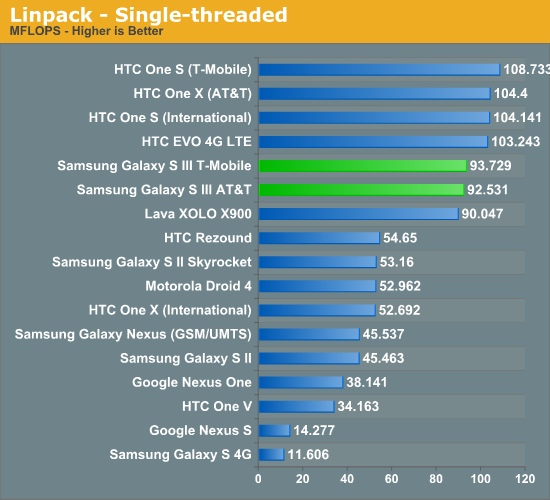
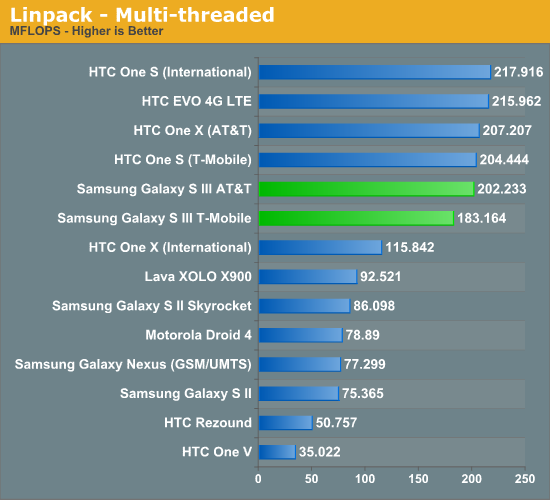
As we’ve shown before, FP performance on Krait is superb thanks to its architectural advantages over a straight A9. I find that FP performance was more relevant of a benchmark when display rendering was being done in CPU instead of on the GPU with the new OpenGL ES 2.0 render paths. Still, it’s worth talking about.
BaseMark OS
Rightware’s BaseMark OS is a general purpose benchmark designed to better simulate overall Android performance. It includes a heavily threaded benchmark, file IO tests, and compression/decompression tasks that all contribute to its overall score.
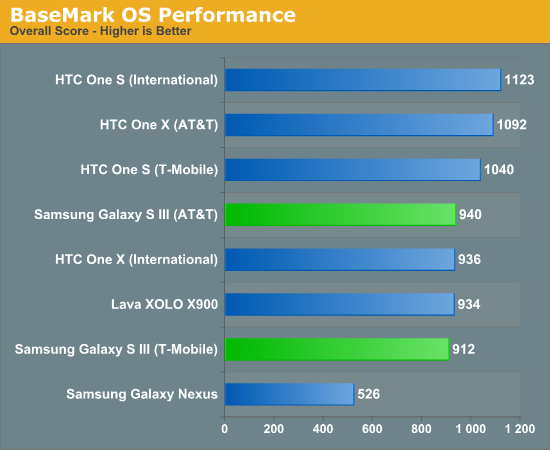
Basemark OS is relatively new to us but we’re adding more and more phones as time goes on for comparison purposes. Curiously enough the SGS3s post numbers a bit shy of their HTC cousins. I think that in spite of this, you’d be hard pressed to tell the Krait based One X and Krait based SGS3 apart.
GPU Performance - GLBenchmark 2.1
As we wait for actual 3D gaming benchmarks to make their way into Android (and hopefully crossplatform) games, we must rely on synthetic tests designed to simulate 3D game performance as best as possible. We start with GLBenchmark, one of the better Android GPU tests on the market today. There are two benchmarks, Egypt and Pro, and each is run in two modes: native screen resolution and offscreen (vsync disabled) at 720p. The latter is more useful for apples to apples comparisons as everything is rendering the same number of pixels, whereas performance in the onscreen tests is determined by the screen resolution of the device along with the performance of its GPU.
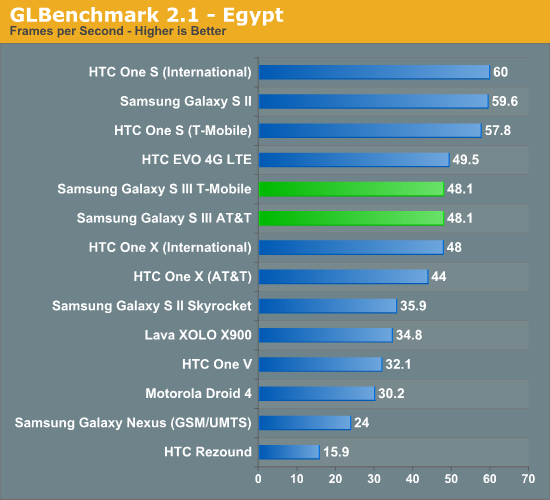
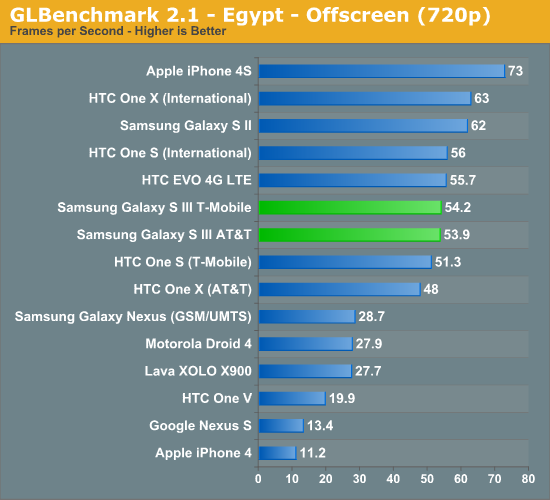
As a reminder, only the Egypt offscreen test takes place with vsync turned off, which is why you see devices with 720p displays posting different results on versus off screen where vsync is off. Part of the deal in getting Krait to market as quickly as possible required that Qualcomm pair the CPU with an older GPU, in this case the Adreno 225 instead of the newer Adreno 3xx offerings due out later this year in SoCs like MSM8960 Pro or the quad core Krait APQ8064. As a result, you can see the SGS2 with Exynos 4210 pull ahead in both tests. Obviously the on-screen test isn’t a totally fair comparison because of the inherent difference in resolution - 720p vs WVGA.
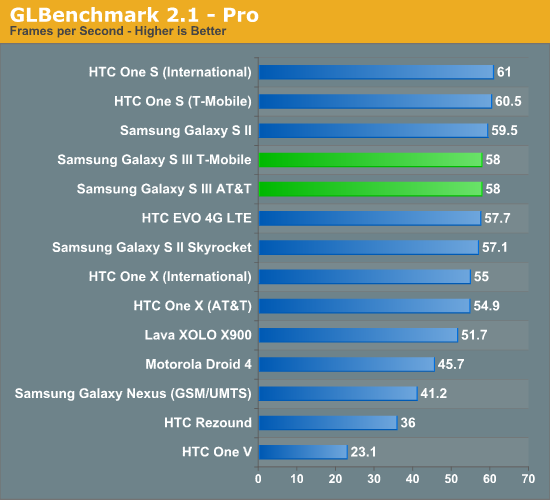
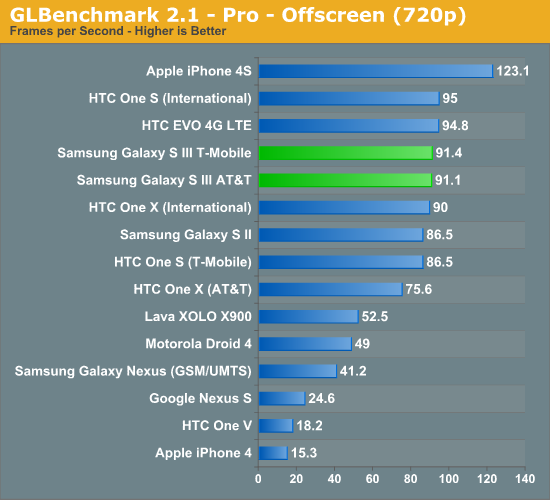
In the older Pro offscreen test, we see Adreno 225 trading spots with SGS2’s Mali–400 and coming out on top.
Basemark ES 2.0 V1
Rightware’s Basemark ES 2.0 V1 is an aging GPU test that tends to favor Qualcomm’s Adreno GPUs above almost all others:
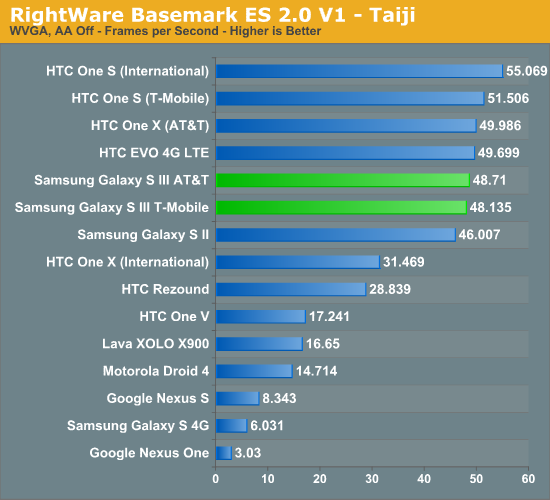
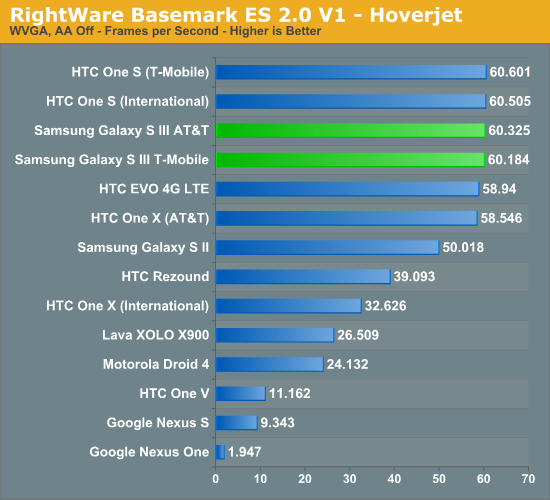
Basemark ES 2.0 is definitely starting to show its age, as Hoverjet is at vsync essentially the whole time, and Taiji is getting there as well. In addition, Qualcomm appears to be using ES 2.0 as an optimization target, so I wouldn’t put too much faith in the ES 2.0 results.


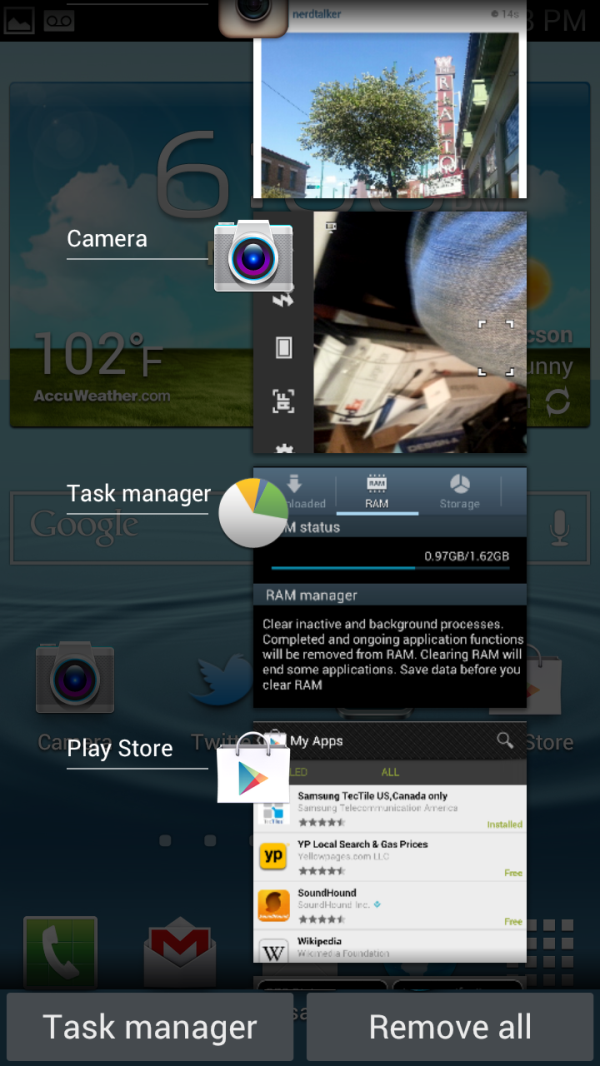
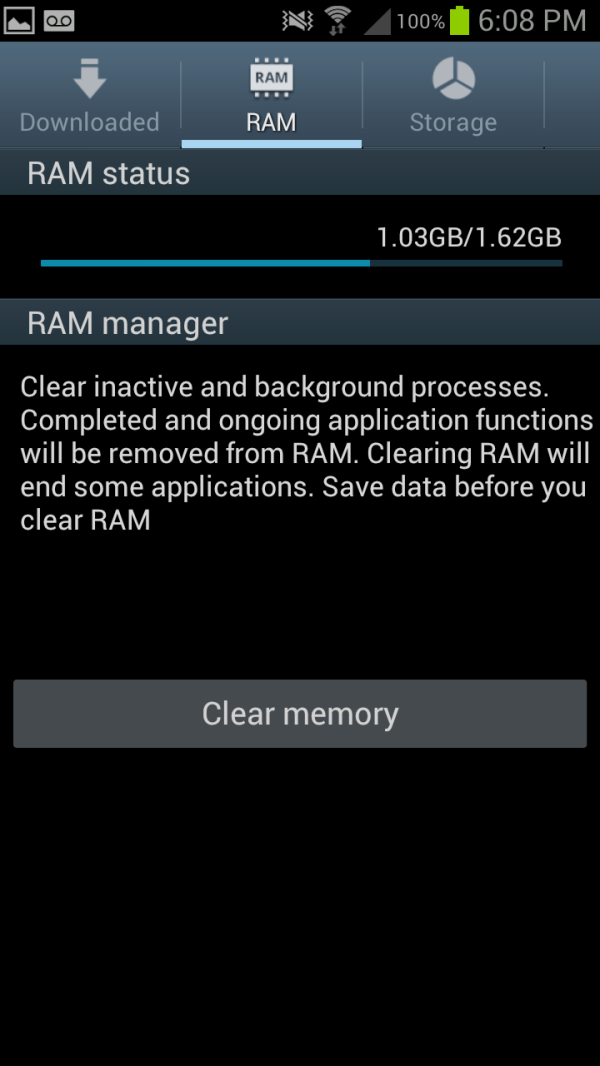








107 Comments
View All Comments
HexiumVII - Wednesday, June 20, 2012 - link
Darn no quad core love for the US?Impulses - Wednesday, June 20, 2012 - link
No big loss, the S4 is roughly equivalent despite being a dual, since it's an all new design instead of a core bump. The GPU is actually the bigger loss, if you're into graphically intensive games.B3an - Wednesday, June 20, 2012 - link
Exactly.The international quad-core version (which i have and love!) is based on ARM Cortex A9. While the US dual-core version uses the Krait SoC which is a lot closer to ARM's new Cortex A15 design (but it's not an A15, it's a custom design from Qualcomm thats similar in performance). So overall for CPU performance the international and US versions are pretty similar.
The international version definitely has a better GPU though - the higher clocked Mali-400 is the fastest GPU in any phone at the moment. Where as the US version has the slower Adreno 225.
On the other hand... the US version has 2GB RAM, where as the international has 1GB.
I guess Samsung felt bad about the slower GPU and tried to make up for it by giving you all 2GB instead.
Personally i prefer the international version because of the extra GPU performance as i do more gaming, and with a screen this big @ 720p gaming is great.
robinthakur - Friday, June 22, 2012 - link
So...quick question. I have an international version which I picked up in HK as well. What games actually make good use of the improved graphics? I've already got Angry Birds Space. I'm not that impressed with the device so far. The thin plastic back feels incredibly cheap for a device costing around £400 and the Android OS seems poorly optimised compared to the iPhone 4S I used to use, with much worse touch controls. The camera which initially sold me (along with the nice water drops animations on the Home screen!) with its rapid shots, also disappoints with pretty mediocre pictures compared to the 4S. Front facing camera is nicer though. The motion controls are utterly pointless as is face unlocking. Have you ever got the wave hand across the screen to take a screenshot to work? I've got it switched on but...nothing! There were plenty of options compared to iOS for to geek out over for 48 hours but now having to actually use the device it seems lacking, i dunno, just unpolished. Considering it just came out, why is text all fuzzy for example? Isn't this a retina display? I assumed that coming out more than 2 years after the iPhone 4, every phone has them these days, but apparently not. I'm considering selling it before the price drops and going back into the Apple Matrix as life seems easier with iOS all told.JamesL88 - Saturday, June 23, 2012 - link
"What games actually make good use of the improved graphics?"Well for starters newest Gameloft games such as the NOVA 3 tend to be very graphically demanding. Also True Android gamers love to buy emulators from black markets (or after markets if you prefer), such as Nintendo 64 emulator.
You're obviously iFan so I'm not going into discussion with strength and weaknesses of each OS, but I believe the GS3 uses the same Sony sensor used in iPhone 4s' camera. I seriously doubt that you even own GS3.
koyanishi - Tuesday, September 4, 2012 - link
I believe he does own a Galaxy S III.that's because he didn't figure out how to take the screen shot by swiping his hand across the screen.
The thing is, to do this your hand has to touch the screen. Your hand is in the form of a karate chop and you use the knife edge (sort to speak) to touch the screen and swipe across it.
I don't think he is that stupid for missing this because I after trying different ways of doing it never figured it out either but only learned of how to do it by reading tips on use of this phone in an android forum.
However on his other points of how the plastic feels cheap and lack of optimization (whatever that means) of the os in GS III I disagree.
bigboxes - Wednesday, June 20, 2012 - link
Am I wrong? The device doesn't look like it can stand up to much of anything. Better make sure you cover it from top to bottom with some kind of case.ATWindsor - Wednesday, June 20, 2012 - link
You probably are, plastics can be very solid and lightweight. The old Galaxy S2 is as far as one can tell much more solid than for instance the iphone.Impulses - Wednesday, June 20, 2012 - link
Samsung's designs may feel cheap at times but that doesn't necessarily translate to better impact survivability... Plastic weighs less and probably absorbs more force during impact... I've never owned a Samsung phone (I'm on my third EVO and my dumb phones were all Nokias & Sony) but I've seen plenty of them fly from my friend's hands. :p The glossy plastic they use probably does scuff easier than most materials tho. Then again, unlike reviewers who go thru phones like underwear, I think the majority of people end up it using cases anyway. I do it to protect my device's resale value as much a anything else.Belard - Wednesday, June 20, 2012 - link
What resale value?